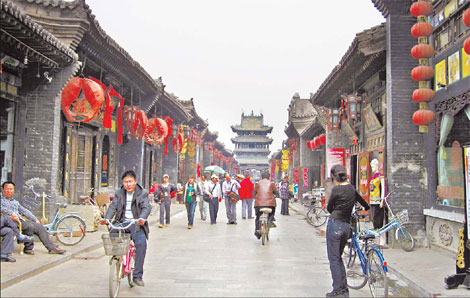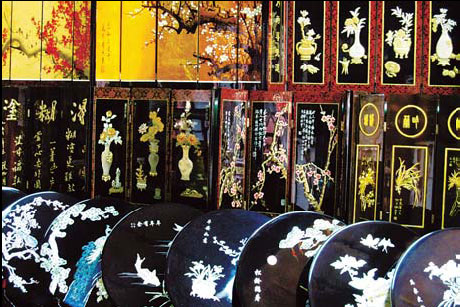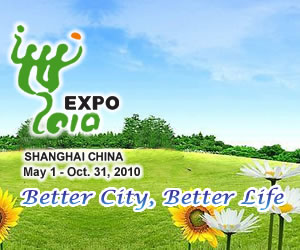Banking on a tortoise
 |
|
Boasting architecture typical of the Ming and Qing periods, Pingyao, Shanxi province, looks like a period-film set. Photos by Tiffany Tan / for China Daily |
|
|
|
Pingyao, a UNESCO World Heritage site, is probably the best-preserved ancient walled city in China. |
Visiting the ancient walled city of Pingyao is a relaxing journey into the past.
After getting punched in the face by a foiled pickpocket and charged half the hotel's daily rate for checking out 20 minutes late while in the capital Taiyuan, Shanxi's ancient city of Pingyao was a balm for body and soul.
The pace of life was unhurried, souvenirs were inexpensive and local businesspeople often treated tourists like visiting friends.
Pingyao, established in the Qin Dynasty (221-206 BC), is probably the best-preserved ancient walled city in China. Its layout follows the auspicious pattern of the shell of a mythological tortoise and boasts Ming (1368-1644) and Qing (1644-1911) architecture, giving it the atmosphere of a period-film set.
While some buildings have been converted into museums, hotels and shops, many are still home to people born and bred in Pingyao, including children gleefully holding water-gun fights and elderly couples conscientiously doing their morning exercise.
Pingyao also holds the distinction of having produced the country's first draft banks and some of the wealthiest merchants in the Ming and Qing periods, but its four centuries of prosperity came to an end in the early 20th century. In 1997, the city was named a UNESCO World Heritage site.
Five hours from Beijing by train, Pingyao in non-holiday seasons can be a weekend retreat for weary urbanites. Upon entering the city gate, get hold of a map, bike (rental 10 yuan, or $1.5, per day), two-day pass to 20 sites (120 yuan) and a nifty audio guide that automatically switches on at important spots around the city (Chinese audio 20 yuan, English 40 yuan, deposit 100 yuan).
Day 1
|
|
|
Scenes of punishment for sinners in the afterlife at the City God Temple |
8 am
Depart for Pingyao via Taiyuan.
2:30 pm: City walls
Pingyao is one of the country's few remaining walled cities. Its walls were built in 1370 to resist invaders and doubled as protection against sandstorms. The crenelated walls, 10 meters high and 6 km in circumference, have 72 watchtowers. Through the North Gate, visitors can walk around the walls and look into some of the courtyard homes. Check out the imposing view of the walls from the outside and the deep ruts left by carriage wheels carting silver coins.
3:30 pm: Rishengchang draft bank
On the east end of Xidajie is Rishengchang, the country's first draft bank, acknowledged as the cornerstone of modern Chinese banking. Originally a dye shop that dealt in remittances, it was turned into a bank in 1824 to facilitate the transfer of huge amounts of silver to and from Pingyao. Local merchants began to prosper through salt and grain trading in the 14th century, when Shanxi province became a critical route for commodities.
By the late Qing period, Pingyao was home to dozens of banks with hundreds of branches nationwide, some overseas. Rishengchang closed in 1948 and its 100-room headquarters is now a museum.
5 pm: City Tower
The tower, located in the city center, is Pingyao's tallest building. For 5 yuan, people can climb up and get a view of the city's layout.
|
|
|
Pingyao is known for its lacquerware, such as fashion jewelry, vases and screens. |
5:30 pm: Former residence of Lei Lutai
Lei (1770-1849) was the founder of Rishengchang and is considered a major figure in Chinese financial history. The residence, on 11 Shuyuan Jie, offers a peek into the life of Pingyao's elite with its four courtyards, wall frescoes and elaborate wood carvings.
6:30 pm: Food Loft
The Western restaurant of the five-star Kylin Grand Hotel, on 76 Chenghuangmiao Jie, offers a good introduction to local specialties like Pingyao beef and wantuzi and kaolaolao wheat noodles. Orders come in small servings (3 to 12 yuan), so customers can experiment and indulge.
8 pm: Shopping
Take a nighttime stroll to enjoy the red lanterns hanging by storefronts, mingle with the locals and do some souvenir shopping. Pingyao is known for its cloth shoes, paper cuts and lacquerware such as fashion jewelry, vases and screens. Goods are surprisingly cheap for a major tourist attraction.
Day 2
9 am: Former county government offices
Pingyao has been the seat of the county government since the Qin, but the existing complex on Yamen Jie was not built until 1346, during the Yuan Dynasty (1271-1368). County government offices played a crucial role in local life as they were where issues like disputes and crimes were resolved - as so often depicted in period TV series.
Pingyao's county offices feature a temple, opera stage and 300 rooms, including a court, prison and military offices. Watch out for the grisly photos of convicted criminals being tortured and mutilated.
10:30 am: City God Temple
The temple, on Chenghuangmiao Jie, is one of the country's last remaining city god temples, built to honor the City God of Justice believed to be the final judge of the souls of the departed. The complex was built in the Ming Dynasty and boasts glazed-tiled roofs, rare murals and altars to the Kitchen God and the God of Wealth.
11:30 am: Confucian Temple
Across from the City God Temple is the eight-century-old Confucian Temple, where imperial civil service exams were held. Among its treasures is a Ming Dynasty examination paper with the highest score for that year as attested by the emperor's stamp, and apparently the only surviving examination paper from the 1,300 years of imperial civil service exams.
12:30 pm: Pingyao Theater Hall
This ornately decorated hall, beside the Confucian Temple, was once the social club for wealthy local merchants. Open 9 am to 9 pm, it is both a restaurant and theater for Shanxi folk dance and music (performances 12:30 and 7:30 pm daily, tickets 60 and 100 yuan). At the entrance is a nine-dragon screen, likened to the one in Beijing's Beihai Park.
2:45 pm
Depart for Beijing via Taiyuan.
 0
0 











Go to Forum >>0 Comments